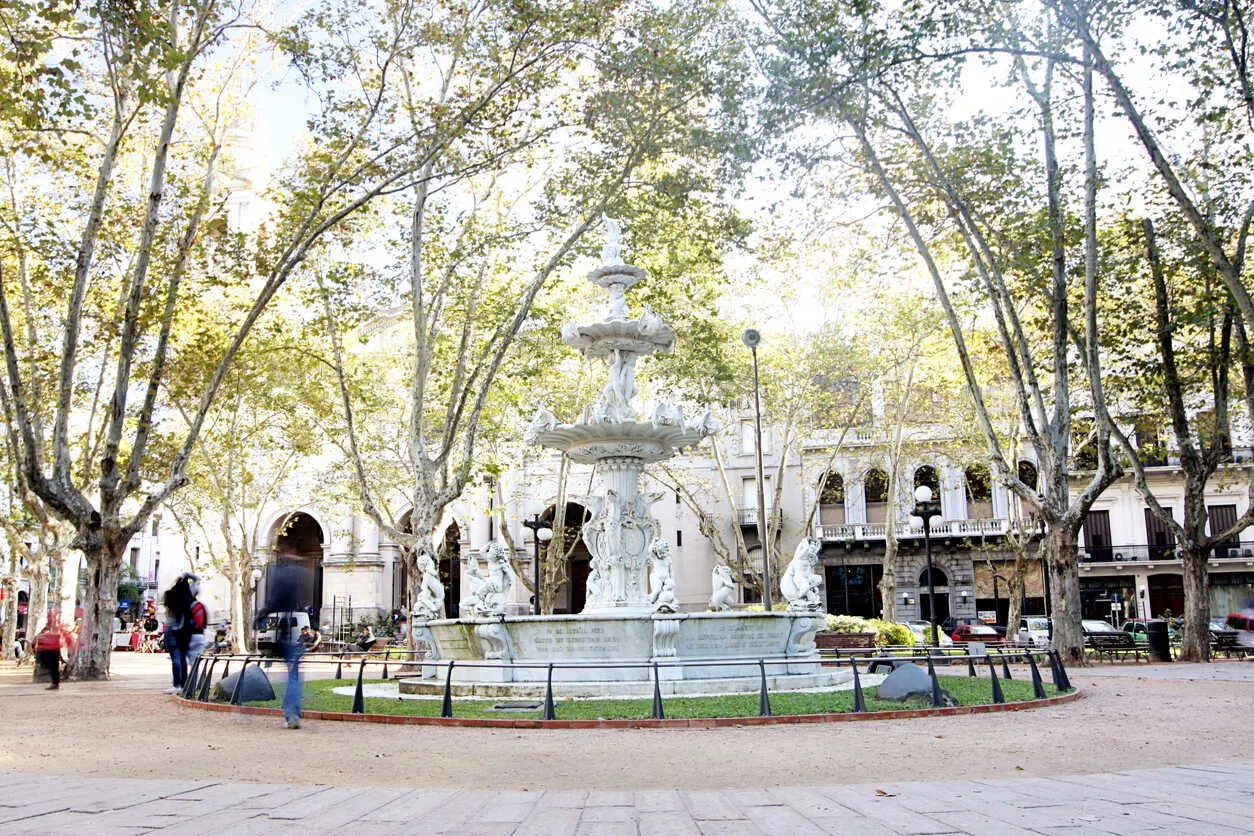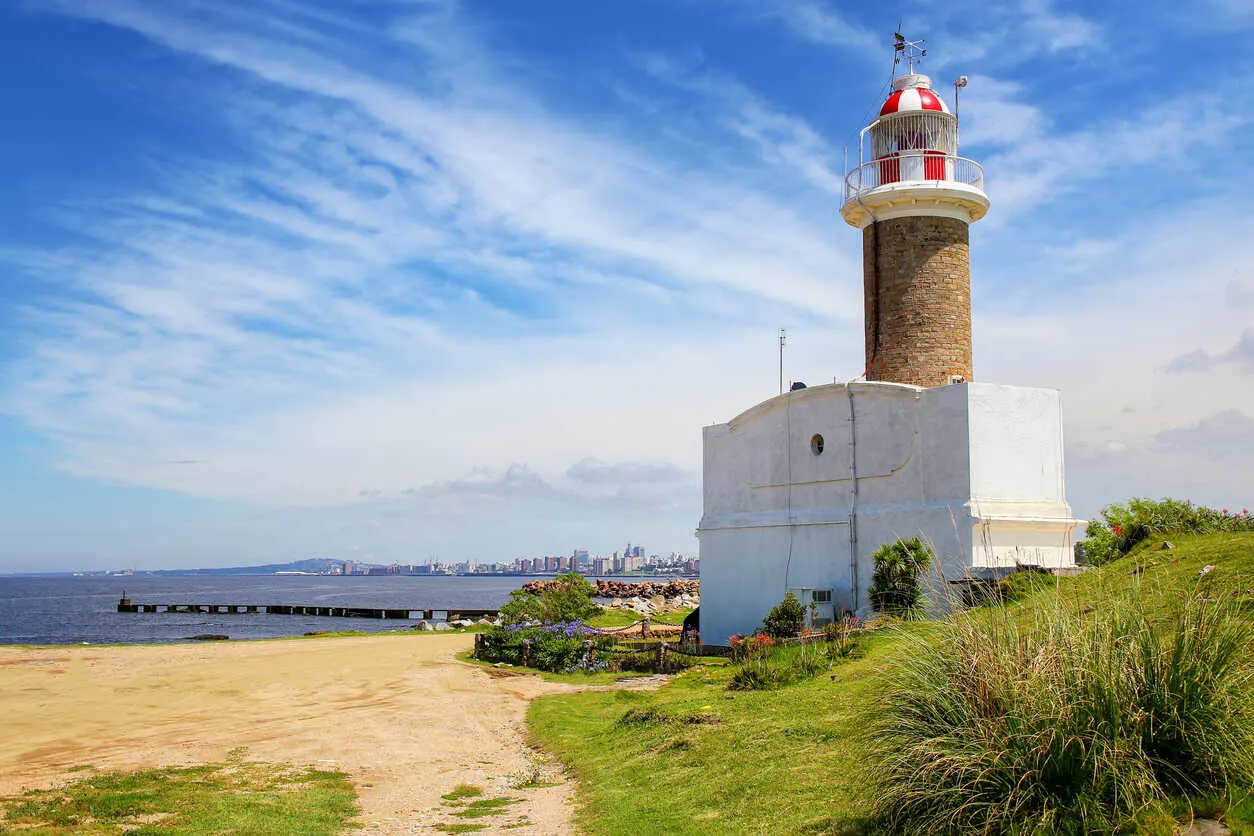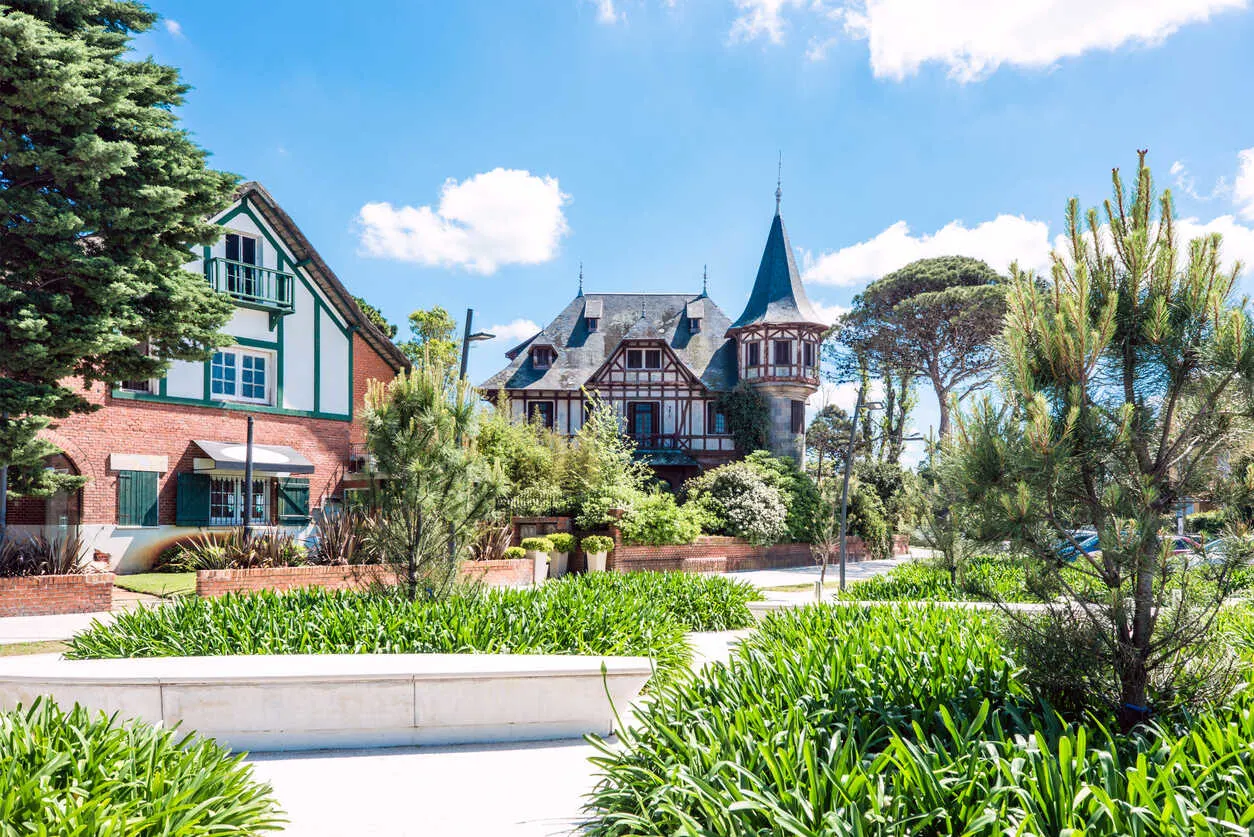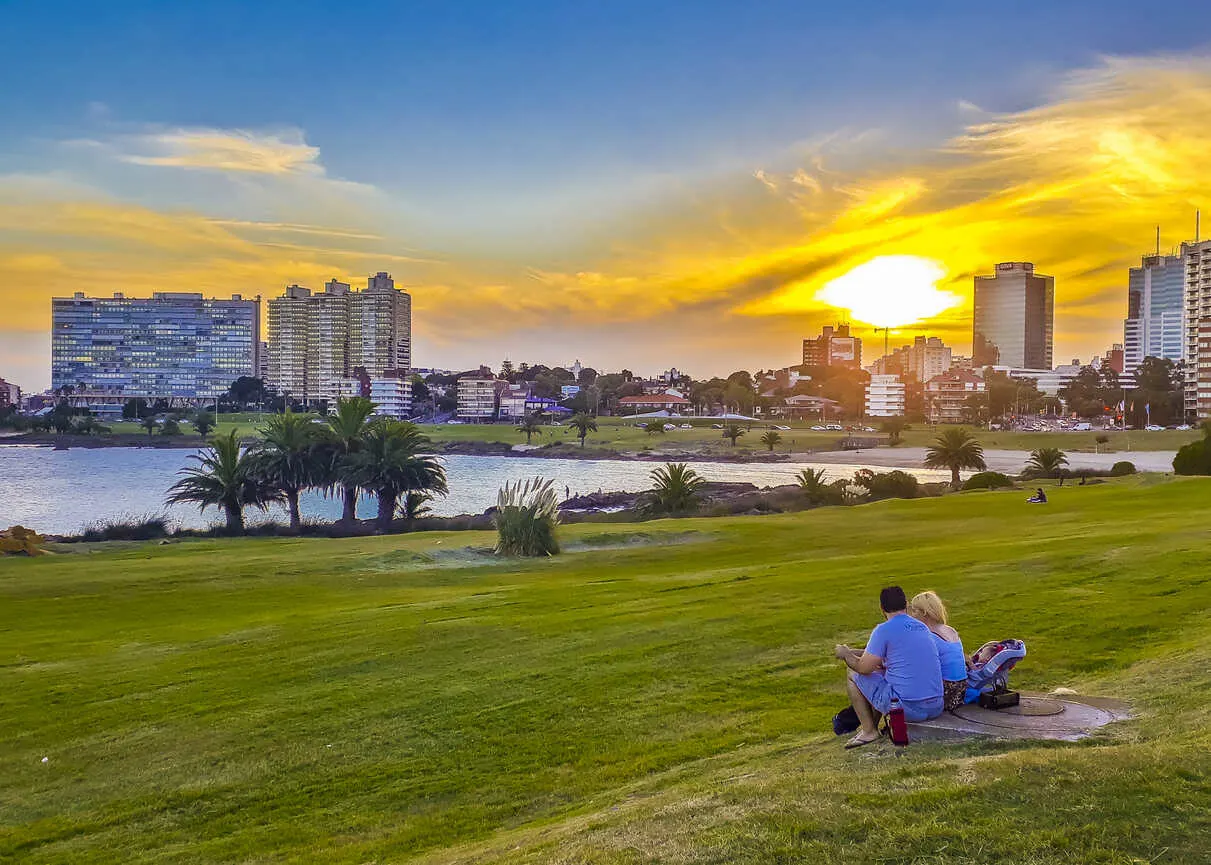I didn’t move to Uruguay for Montevideo. I came for the beach—sunny days in Punta del Este and a simple life by the sea. But over time, it was the capital—gritty, elegant, endlessly walkable—that quietly won me over.
Now it’s home.
I moved from Washington State to Punta del Este in 2006, and two years later, I bought an inexpensive second apartment in Montevideo. (At that time, it cost only $26,000!)
For years, I stayed in my Montevideo place when I rented out my Punta del Este apartment during the summer high season—earning enough to cover the ownership costs of both apartments for the whole year. In 2014, I downsized, selling my place in Punta del Este and moving to Montevideo for good.
Year after year, Montevideo is ranked as the best South American city for quality of life. And having lived here for more than a decade, I can tell you why…
Montevideo is famous for its Rambla, a 13-mile coastal promenade popular with walkers, runners, and rollerbladers. Some sections, along the seawall and nearby rocks, are good for cast fishing when the conditions are right. Other sections with benches, great views, and a cool breeze are ideal for a picnic and chat with friends on warm summer evenings.
Your chance to retire overseas now
Your chance to retire overseas now
Learn more about Uruguay and other destinations by signing up to our daily IL Postcards e-letter and we'll immediately send you a free report: 20 Countries Compared, Contrasted, Ranked, and Rated.
You don’t have to be rich to enjoy a pampered retirement, you just need to know where to go.
With our 34th Annual Global Retirement Index, our experts hand you a detailed roadmap. Details and a Special Offer Here!

By submitting your email address, you will receive a free subscription to IL Postcards, The Untourist Daily and special offers from International Living and our affiliates. You can unsubscribe at any time, and we encourage you to read more about our Privacy Policy.
Montevideo: A Simple Good Life by the Sea
Most days, I walk on the Rambla. A few times a week, I go to the gym. To socialize, I enjoy chatting while walking or in a café over coffee.
We have a wide selection of restaurants, interesting stores, movie theaters, live music venues, and nightclubs. Outdoors, I can enjoy large green parks, tree-lined streets, and several sandy beaches.
Summer in Montevideo is a busy time. Christmas, New Year, and the start of the 40-day Carnival season come one after the other. For weekend getaways, I can head to Punta del Este, or one of the many other smaller beach resort towns that dot the coast between Montevideo and the Brazilian border. A popular winter getaway is in the northwest hot spring region, near the city of Salto.
The big winter holiday—unique to Uruguay—is la Noche de la Nostalgia (The Night of Nostalgia). It’s an "oldies" music dance party celebrated on August 24—the night before Uruguay’s Independence Day.
Noche de Nostalgia parties take place in casinos, nightclubs, hotels, restaurants, as well as more offbeat locations, like warehouses. They usually include DJs, mirror balls, and black lights. It’s a night to dress retro, let down your hair, and dance to the music clichés of the ’70s, ’80s, and ’90s.
Another great thing about Montevideo: it’s in Uruguay—the most economically, socially, and politically stable country in the region.
This City is 62 Small Towns
While Montevideo is a big city, it’s comprised of 62 distinct neighborhoods—like 62 connecting small towns, each with a unique character.
Montevideo fronts the Rio de la Plata (River of Silver).
As we embark on a tour of three Montevideo neighborhoods, the first is where I live. The other two are places where I often visit friends—each with a unique character that I love and appreciate.
No Car Needed in Two Historic Neighborhoods

Ciudad Vieja and Centro are two adjoining neighborhoods that form Montevideo’s historic district. This is where I live, in Montevideo’s leading tourism, cultural, and business center.
Here we have Montevideo’s original plazas and earliest architecture. It’s also where you find the most significant concentration of hotels, restaurants, live performance theaters, museums, galleries, nightclubs, and government and business offices.
Most of us do our day-to-day shopping on foot in close-by neighborhood markets, butcher shops, bakeries, greengrocers, pharmacies, and hardware stores. Street markets set up twice per week selling a wide range of produce, fish, and sometimes chicken.
I often buy fresh corvina, a local fish with firm white meat, at my neighborhood street market. When I buy meat I talk to my butcher who cuts it the way I like it. When I went low carb and stopped buying potatoes, my greengrocer noticed and was curious about the change. Shopping here involves more interaction that fosters a sense of community.
Both neighborhoods enjoy good bus and taxi service, so they’re easy places to live without a car.
With all the period architecture, Ciudad Vieja is popular with filmmakers. So, in addition to all the tourists you frequently see film industry equipment trucks, trailers, and workers.
Residents from other parts of Montevideo come to Ciudad Vieja to shop in its specialty stores, eat good food, go to a nightclub, or see a performance at the Solís Theater, a beautiful neoclassical building which opened in 1856.
Compared to the high volume of people coming and going, the number of us living in Ciudad Vieja is small—about 16,000. We’re a mix of middle-class, working-class, and low-income folks, which includes a few neighborhood characters. On weekends, with the workers gone, things get quieter, with most of the activity around the neighborhood’s restaurant scene.
Food choices include traditional Uruguayan barbecue, Italian food, fish, as well as international and fusion cuisine.
The most famous place to eat in Ciudad Vieja is the Mercado del Puerto (Port Market), a spacious building full of traditional Uruguayan barbecue restaurants, where chefs cook meat and vegetables on huge grills over wood coals.
While many barbecue places here are good, my personal favorite Mercado del Puerto restaurant is Estancia del Puerto. Mostly because it’s been around for a long time, and is a family tradition for my Uruguayan friends who grew up in Montevideo. It’s also where Anthony Bourdain ate during an episode of No Reservations in 2008. It’s the insider’s choice.
Sometimes, I walk on the Rambla with my friend Mike Franz. He and his wife Ligia moved from the US to Ciudad Vieja in 2017. "What attracted us was the multi-cultural diversity, the wonderful coffee shops, and of course, the bustling port only blocks away," he says.
"Carnival is also a delight. We believe this is the best possible place to live in Montevideo!" he adds.
Where Centro meets Ciudad Vieja you’ll find Plaza Independencia, Montevideo’s largest plaza, landscaped with lawns, benches, trees, and a cherub fountain in each of its four corners. In the middle is a tall bronze statue of General José Artigas, Uruguay’s national hero.
One of the buildings adjacent to Plaza Independencia is the office of Uruguay’s president. So, the plaza is frequently used for national public ceremonies. (And once in while, protests.)
Nearby is the Salvo Palace, an elaborately designed 300-plus-foot-tall structure completed in 1922. In its early days, the Salvo Palace was among the tallest buildings in Latin America. While originally built to be a hotel, by the 1930s it ended up serving as a popular dance hall, literary venue, and residences for artists.
A fun place to visit on late weekend afternoons is Centro’s Plaza Fabini, where people come to dance street tango.
Patrick Goodrich is an expat from the US who moved to Montevideo nine years ago. "I’ve lived in Centro for the last five years," he says. "It has all kinds of stores, hustle and bustle, lots of bars and dance clubs! Everyone comes here to shop, party, protest, and celebrate. I love being in the center of it all."
In Ciudad Vieja or Centro, you can find studio apartments for around $100,000 and modern two-bedrooms for $145,000 to $185,000.
As for rentals, there is a wide range priced between $680 and $930 per month. Whether you buy or rent, gastos communes (common expenses) pay for the upkeep of buildings and grounds, and run from $110 to $225 per month.
Punta Carretas—Upscale, Urban

With a lighthouse and a sprawling lawn waterfront, Punta Carretas is a residential neighborhood where locals enjoy playing fútbol (soccer) and cricket. It’s also among the most coveted communities in Montevideo for both Uruguayans and expats.
Its three-level mall, Punta Carretas Shopping, has a multiplex where many English-language movies are shown. Next to the mall is a large supermarket called Disco Fresh Market, offering a vast selection of foods, including many imported brands.
There’s also a huge Saturday outdoor market featuring produce and goods, which includes many handmade craft items, at Villa Biarritz Park.
For families, you find respected private primary and secondary schools. And Punta Carretas is also home to the 18-hole Uruguay Golf Club.
Karin Ledl moved from the US to Punta Carretas in 2011. "Punta Carretas is safe," she says. "It’s a vibrant neighborhood with good shopping and restaurants, and I’m right by the Rambla. Plus, everything is close enough that I can walk."
Most people in Punta Carretas live in modern apartments in 10-story buildings. You can find a selection of two-bedrooms for sale in the $245,000 to $390,000 range.
Lovely two-bedrooms for rent start at $1,125 per month.
You can also find attractive front-line two-bedroom apartments overlooking the water for $1,900 per month.
Your chance to retire overseas now
Your chance to retire overseas now
Learn more about Uruguay and other destinations by signing up to our daily IL Postcards e-letter and we'll immediately send you a free report: 20 Countries Compared, Contrasted, Ranked, and Rated.
You don’t have to be rich to enjoy a pampered retirement, you just need to know where to go.
With our 34th Annual Global Retirement Index, our experts hand you a detailed roadmap. Details and a Special Offer Here!

By submitting your email address, you will receive a free subscription to IL Postcards, The Untourist Daily and special offers from International Living and our affiliates. You can unsubscribe at any time, and we encourage you to read more about our Privacy Policy.
Carrasco—For Suburban, Spacious Living

On the very east side of Montevideo is Carrasco, a low-density neighborhood of mostly single-family homes with some spacious apartments in low-rise buildings.
Carrasco is coastal, with a long sandy beach where you can buy fresh fish, just off the boat.
Across the street from the beach is the grand 5-star Sofitel Montevideo Casino Carrasco & Spa, a building inaugurated in 1921.
The best area of Carrasco is along Arecena, the main commercial street, where you find most of the shopping and several restaurants. The neighborhood is known for its long-established private primary and secondary schools, as well as sports clubs, including the Carrasco Polo Club and the Carrasco Lawn Tennis Club.
If you come here, visit my favorite Carrasco restaurant, Alquimista, located in an elegantly renovated 1925 home. It’s run by an English/Uruguayan couple, Mark and Carolina, who bought the house with the idea of turning it into offices, but went with "the romantic option of setting up a boutique hotel and restaurant."
Alquimista’s menu changes about every two months and includes traditionally prepared English dishes crafted from carefully sourced local ingredients. They also offer a popular afternoon tea.
Regarding Carrasco as a place to live, Mark appreciates its quick access to the Montevideo Airport. "It’s also the area with the highest concentration of the best schools. There’s a vibrant restaurant scene, and-Carrasco Beach is a sociable place to walk… or run… and build up that appetite!" he adds.
You can find a selection of newer three-bedroom, three-bathroom, single-family homes with yards here from $640,000 to $800,000.
Older single-family homes rent for $2,150 to $2,350, while newer ones in top locations start at around $4,500.
Most people here get around driving their own car.
Why Uruguay Sits Atop the "Most Stable" List

With a strong economy, the highest per capita income in South America, and the largest middle class (60% of the population) in Latin America, Uruguay can afford a high level of social spending (around 25% of GDP).
And because Uruguay ranks as the least corrupt country in Latin America, more public spending goes toward building a good society.
In Uruguay, all workers receive a comprehensive healthcare plan, 20 days of paid vacation per year, and a state-managed pension. Anyone who meets the academic requirements can attend the state university at almost no cost. Everyone has access to healthcare without going into debt. And food and shelter are available for those in need. As a result, Uruguay maintains the lowest poverty rate in Latin America.
It’s also the most democratic country in Latin America.
Though Uruguay is not "cheap" (it’s on the expensive side for Latin America), you can live in Montevideo for a lot less than a similar lifestyle in the US.
A set lunch special, which includes meat or fish, a salad, and a side dish, along with a glass of wine or a soft drink, and a dessert, costs me around $26 per person, including tip.
I compared supermarket prices in Montevideo to the prices where I used to shop when I lived in Washington State. Processed and packaged foods cost more in Uruguay. Most whole foods, such as milk and eggs, cost about the same. The one thing that cost significantly less in Uruguay (up to 50% less)… is the beef.
Most imported goods, including furniture and clothing, cost more in Uruguay than in the United States. The same is true of gas for your car and electricity for your home… computers, cellphones, and other electronics… and vitamin supplements. (Many expats shop for clothes, computers, and vitamins when they visit the US)
So where do the savings come from? Things that can cost significantly less include big-ticket items like housing… and healthcare.
Most expats here obtain a private comprehensive healthcare membership plan called a mutualista, which costs around $90 per month, with a small copayment when they use a hospital service. A separate private medical response plan, that sends an ambulance with a doctor to your home in case of an emergency, costs around $30 per month.
In Montevideo, with neighborhood shopping, reliable bus service, and plentiful taxis, it’s easy to get by without a car. A bus ride costs about $1.50 each way. A five-mile taxi ride is about $10.50, while a bus ticket for the 80-mile ride between Montevideo and Punta del Este is about $11.
A couple living in Montevideo’s Ciudad Vieja, Centro, or Cordón neighborhoods might spend $3,550 per month, including rent and all utilities, comprehensive healthcare plans with emergency service, and two basic cellphone plans. On this budget they would get around by bus and not own a car, but they would have a $900 allowance for extras, such as dining out, clothes, travel, gifts, alcohol, and home repairs.
A couple that owns their apartment can expect to spend about $2,850 per month on a similar lifestyle.
Your chance to retire overseas now
Your chance to retire overseas now
Learn more about Uruguay and other destinations by signing up to our daily IL Postcards e-letter and we'll immediately send you a free report: 20 Countries Compared, Contrasted, Ranked, and Rated.
You don’t have to be rich to enjoy a pampered retirement, you just need to know where to go.
With our 34th Annual Global Retirement Index, our experts hand you a detailed roadmap. Details and a Special Offer Here!

By submitting your email address, you will receive a free subscription to IL Postcards, The Untourist Daily and special offers from International Living and our affiliates. You can unsubscribe at any time, and we encourage you to read more about our Privacy Policy.
